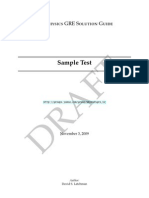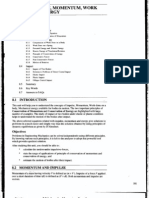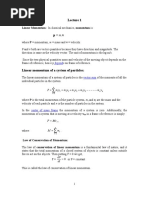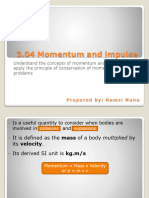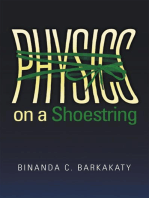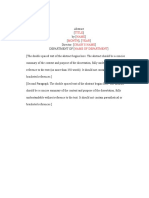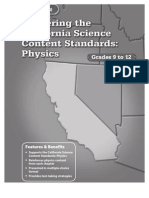A2 Unit 4 Sample Page
A2 Unit 4 Sample Page
Uploaded by
SyEd Mohammed IfrahimCopyright:
Available Formats
A2 Unit 4 Sample Page
A2 Unit 4 Sample Page
Uploaded by
SyEd Mohammed IfrahimCopyright
Available Formats
Share this document
Did you find this document useful?
Is this content inappropriate?
Copyright:
Available Formats
A2 Unit 4 Sample Page
A2 Unit 4 Sample Page
Uploaded by
SyEd Mohammed IfrahimCopyright:
Available Formats
www.alevelphysicsebooks.
com
Succeed in A level Physics
By
Dr. W. Lance M.D. Keller
Thomas J.R. Hughes
Copyright 2011 alevelphysicsebooks.com. All Rights Reserved
http://www.alevelphysicsebooks.com/
No parts of this book may be reproduced, stored in a retrieval
system, of transmitted, in any form or by any means, electronic,
mechanical, photocopying, recording, or otherwise, without the
prior written permission of the publisher.
The distribution and sale of this product are intended for use of
the original purchaser only and for use only on a single
computer system.
Duplicating, selling, or otherwise distributing this product is a
violation of the law
http://www.alevelphysicsebooks.com/
0
www.alevelphysicsebooks.com
Unit 4 PHYA4 Fields and Further Mechanics
4.1 Further Mechanics
4.1.1 Momentum concepts
4.1.1.1 Momentum and impulse
(i) Definition Momentum:
The product of an objects mass m and velocity v is called its momentum:
momentum mv =
Momentum is measured in
1
kgms
. It is a vector.
(ii) The rate of change of momentum and Newtons second law
The rate of change of momentum of an object is proportional to the
resultant force acting.
This can be written in the following form:
change in momentum
time taken
tan resul t force =
In symbol:
mv mu
F
t
=
Where v is final velocity, u is initial velocity of an object.
Equation can be rewritten
( ) m v u
F
t
=
v u
a
And the acceleration is given by
t
= . So
F ma =
1
www.alevelphysicsebooks.com
Note:
Equation and are therefore different versions of the same
, remember that F is the resultant
follows:
principle (Newtons second law).
when using equations and
force acting. For example, for the figure below, the resultant force is
26 20 6N = to the right. The acceleration a can be worked out as
2
6 F
a 3
2
ms
m
= = =
ii) Impulse
nt force,
(i
Impulse:
( ) m v u
F
t
= As resulta can be rewritten Ft mv mu =
In words force time=change in momentum.
The quantity force time is called an impulse.
A given impulse always produces the same change in momentum,
irrespective of the mass. For example, if a resultant force of 6 N acts for
2s, the impulse delivered is 62=12N s.
This will produce a momentum change of
1
12kgms
So a 4 kg mass will gain
1
3ms
of velocity
Or a 2 kg mass will gain
1
6ms
of velocity, and so on.
2
www.alevelphysicsebooks.com
The graph below is for a uniform force of 6 N. in 2s, the impulse
elivered is 12 Ns. numerically, and this is equal to the area of the graph d
between the 0 and 2 s points.
(i v) impulsemomentum theorem
rom section (iii), we get that:
n momentum.
s called an impulse.
s:
an object, the impulse of the resultant
equal to the change in momentum of the object; this statement is
F
The resultant force time = change i
And the quantity force time i
So
Impulse = change in momentum.
Thu
When a resultant force F acts on
force is
called impulsemomentum theorem:
Ft mv mu =
mv
: The final momentum
tial momentum
mu
: The ini
3
www.alevelphysicsebooks.com
orked examples
tial momentum:
i
4.1.1.2 W
1. a baseball of mass m = 0.14 kg has an initial velocity of s as
it approaches the bat. We have chosen the direc
The initial
(b) The impulse produced by the bat.
Ini
38 / u m =
tion of approach as the
arger than negative direction. The bat applies a force that is much l the
weight of the ball, and the ball departs from the bat with a final velocity
of 58 / v m s = + . The contact time between the bat and the ball is
3
4.0 10 t s
A = . Find
(a) and final momentum of the ball.
(c) The average force exerted on the ball.
Solution:
(a) Strategy:
momentum mv =
So
p m 0.14 ( 38) 5.32 / u kg m s = = =
0.14 ( 58) 8.12 /
f
p mv kg m s = = + = Final momentum:
(b) Strategy:
The equation impu e l ctly to calculate
ince the average force that the bat applies to the ball is not
se = force time can not be used dir
the impulse, s
known. However, since the weight of the ball is negligible, the force
4
www.alevelphysicsebooks.com
applied by the bat is the net force, and the impulse of the net force equals
the change in momentum, according to the impulsemomentum
theorem:
Impulse = change in momentum
That is
8.12 ( 5.32) 13.4 Ft mv mu k = = = + / g m s
So the impulse produced by the bat is 13.4 / kg m s +
(c) Strategy:
contact is al Now that the impulse is known, the so known. So use the
ulse = force time to calculate the average force. equation: imp
So
3
13.4 /
3350
impulse kg m s
F N
4.0 10 t s
A
The force is positive, reflecting the fact that it points opposite to the
b
4.1.1.3 Principle of conservation of linear momentum
(i) Principle of conservation of linear momentum:
otal momentum after
+
= = = +
velocity of the approaching all.
Provided there are no external forces acting on a system, the total
momentum before collision is equal to the t
collision.
For a collision involving two bodies (figure 4.1.1.3), the conservation law
5
www.alevelphysicsebooks.com
can be expressed symbolically as:
1 2 1 2
1 2 1 2
M v M v M v M v
' '
+ = +
Note: , 1 v
2 v
, 1 v
'
, 2 v
'
are all vectors, and in your calculations, you
must be pay attention to the direction of the velocity.
ven though momentum is always conserved in collisions, kinetic energy
For this reason, we usually classify
(ii) Elastic and inelastic collisions
E
may or may not be conserved.
collisions according to whether kinetic energy is conserved of not. If
kinetic energy is conserved during a collision, we call it an elastic
collision. At other extreme are collisions in which two objects stick
together after impact. These collisions are known as perfectly inelastic
collisions. A collision between two railroad cars that couple together upon
impact is an example of a perfectly inelastic collision. In between are the
6
www.alevelphysicsebooks.com
inelastic collisions that are neither elastic nor perfectly inelastic.
4.1.1.4 Worked examples
1. Two cars of unequal mass undergo a head-on collision in which they
stick together after the collision (figure 4.1.1.4). Car A has a mass of 1700
lision?
(b) what is the accelerations of the two cars during the collision ?
kg and an initial velocity of 10 km/h. car B has a mass of 850 kg and an
initial velocity of 12 km/h toward the car A. the impact time is
2
1.0 10 / m s
.
(a) What is the velocity of the combination immediately after col
Strategy: use the Principle of conservation of linear momentum,
2 1 2 1
1 2 1 2
M v M v M v M v
' '
+ = +
, since the two cars stick together, so
7
www.alevelphysicsebooks.com
1 2 v v v
'
= =
' '
,
Thus
1 2 ( )
A B
B A
M v M v M v M
'
+ + =
And choose the direction of the car A as the positive direction. Then
1 10 / km h = , 2 12 / v km = v h
Solutions:
1 2
B A
M v M v +
(a) Total momentum before collision =
= 1700 10 850 ( 12) 6800 / kg m s + =
Total momentum after collision = (M )
A B
M v
'
+
50 v = 25
'
linear momentum:
2.67 / v m s
'
= +
(b) Strategy: the accelerat
From the Principle of conservation of
6800 / 2550 kg m s v
'
=
Then
v u
a
t
=
A
ion is the rate of change in velocity,
Solution:
Car A:
6 2
2
2.67 / 10 /
2.64 10 /
1
1.0 10
3600
A
chan
a =
ge in velocity km h km h
km h
impact time
h
+
= =
Car B:
8
www.alevelphysicsebooks.com
6 2
2
2.67 / ( 12 / )
5.28 10 /
1
1.0 10
3600
B
change in velocity km h km h
a km
impact time
h
+
= = =
4.1.2 Circular motion
.1.2.1 Curvilinear motions
otions that the direction of the velocity is
changeable with time.
The conditions for a body to be in curvilinear motion: for a body, if the
t line. The net force changes both the magnitude
h
4
Curvilinear motions: m
direction of the net force acted on it and the velocity of the acceleration is
not in the same straigh
and the direction of the velocity; the body is in curvilinear motion.
4.1.2.2 Uniform circular motion
a particle, moving along a circle, passes an equal arc length in equal If
9
www.alevelphysicsebooks.com
time, this motion is called uniform circular motion.
Consider a particle moving in uniform circular motion.
How is the speed of uniform circular motion described?
1. Linear velocity
Linear velocity: the arc length per unit time.
In symbol
s
v
t
=
Where s is the arc length, t is time taken, v is linear velocity.
ar
motion, and linear velocity is a vector, the direction of one point in
circular motion is the tangent direction of the circumference at the point.
2. Angular velocity
(i) Radians and degrees
Note: linear velocity is the instantaneous velocity of a body in circul
10
www.alevelphysicsebooks.com
In circular motion, it is convenient to measure angles in radians rather
than degrees.
we define the angle in radians (rad), u , to be the ratio of the arc
length s to the radius r. (Figure 1)
( )
arc length
rad u =
radius of circle
In symbol
s
r
u
Thus One radian (rad) is defined as the angle subtended at the centre of a
circle by an arc equal in length to the radius. (Figure 2)
So if we let the arc length become the entire circumference of the circle,
then 2 s r t = . Thus the angle in radians generated in going around a
complete circle is 2t . We can say that the angular change in a full
rotation is either 360or 2t radians, depending on which unit of
angular measure is used.
The relationship between the radian and the degree is
0
2 360 rad t =
11
www.alevelphysicsebooks.com
So
0
0
360
1 57.3 rad = =
2t
0
0
2
1 0.0175
360
rad
t
= =
(ii) Angular velocity
he velocity of uniform circular motion can be described by angular
speed,
T
velocity too.
And the angular speed is defined as the angle swept out by the radius per
second.
In symbol
Angular
t
u
e =
Unit: radians per second (rad/s), sometimes in rad/min.
3. Time period, frequency and rotational speed
(i) Time period
12
www.alevelphysicsebooks.com
The time a body in circular motion takes to complete a revolution is
ution, the arc length
called a period. (In symbol T)
So for one revol 2 s r t = , the angle 2 u t = .
uency. It is denoted by f (in Hz),
(ii) Frequency
The reciprocal of period is freq
1
f
T
=
(iii) Rotational speed
It is denoted by n. its unit is revolutions per second, symbolized by r/s or
revolutions per minute, symbolized by r/min.
4. Relationship between linear velocity, angular velocity and period
If a body is in uniform circular motion along a circumference of radius r,
the arc it covers in a period T is
Rotational speed measures the amount of revolutions per second.
, and the angle is 2t 2 r t . Hence the
linear and the angular velocities are respectively
Linear velocity
2 r t
v
T
=
Angular velocity
2
T
t
e =
From above two equations,
v re =
4.1.2.3 Worked e s x e
dius of 0.3 m and is being rotated at 850
ampl
1. The wheel of a car has ra
13
www.alevelphysicsebooks.com
revolutions per minute (rpm) on a tire-balancing machine. Calculate
(a) Time period of the wheel
uter edge of the wheel is moving.
r of
evolution is:
(b) The speed at which the o
Solutions:
(a) Since the tire makes 850 revolutions in one minute, the numbe
minutes required for a single r
3
1
1.2 10 min/
850
revolution
rpm
=
3
1.2 10 min 0.072 T s
= = Therefore, the time period is
(b) The speed v can be obtained directly from
2 r
v
T
t
= .
So
2 2 3.14 0.3
26 /
r
v m s
T 0.072
t
= = =
30 cm
ular speed of th
e peed.
2. The drum of a spin dryer has a radius of and rotates at 800
tions per minute. Calculate
(a) the ang e drum.
(b) th linear s
trategy: we can obtain the angular speed directly from
revolu
2
T
t
e = S , so we
uired for a single revolution is:
firstly need the time period. Since the drum rotates 800 revolutions in one
minute, the number of minutes req
3
1
1.25 10 min/ revolution =
Therefore, the time period is
800rpm
3
1.25 10 min 0.075 T s
= =
14
www.alevelphysicsebooks.com
Solutions:
2 2
83.7 /
t
(a) rad s
0.075 T
t
e = = =
(b) The relationship between linear velocity and angular velocity is:
v re =
S
tripetal force and centripetal acceleration
e
an
s m moving at a speed v on a circular path of radius r and
o
2
30 10 83.7 2 re
= = =
ntripetal force
ect of m
agnitude given by
5.1 / v m s
4.1.2.4 Cen
1. C
(i) Magnitude: the centripetal force is the net force required to keep
obj as
has a m
2
c
mv
F
r
=
(ii) Direction: the centripetal force always points toward the center of the
y changes direction as the object moves. circle and continuall
(iii) Fromv re = ,
2 2
2
( ) mv m r
F mr
e
c
r r
e = = =
And
2t
T
e =
Thus
2
2 2
2 4
( )
mr
F mr mr
t t
e = = =
2 c
T T
2. Centripetal acceleration
15
www.alevelphysicsebooks.com
By Newtons second law, F = ma
Thus
2
c
2
v
F ma a
r r
= = =
,
mv
At the same way, from equation and
2
2
4 r
a r or a
2
T
t
e = =
So the centripetal acceleration of an object moving with a speed v on a
circular path of radius r has a magnitude
2
v
c
a
r
=
Or
2
c
a re =
2
4 r
2
c
a
T
t
=
Direction: the centripetal acceleration vector always points toward the
center of the circle and continually changes direction as the object moves.
4.1.2.5 Worked examples
1. A bicycle racer rides with constant speed around a circular track 30 m
in diameter (figure 4.1.25). What is the acceleration of the bicycle toward
the center of the track if its speed is8.0 / m s ?
16
www.alevelphysicsebooks.com
Strategy: since the speed around the circle is constant, we can compute
the acceleration directly from the equation:
2
c
v
a
r
=
Solution:
2 2
2
8
4.3 /
15
c
v
a m
r
= = = s
ntripetal acceleration of the mass.
(b) The tension in the string
Solu n
) We can obtain the centripetal acceleration of the mass directly from:
2. a 0.5 kg mass attached to a 2 m long string is whirled around in a
horizontal circle at a speed of 8.0 / m s . Calculate
tio s:
(a) The ce
(a
2 2
8
2
c
v
r
2
32 / a m s = = =
ipetal force required to keep
T = ma.
(b) The tension in the string exerts the centr
the mass in circular motion. This force is
17
www.alevelphysicsebooks.com
So the tension in the string is given by
3. A body of 3 kg moves along a circumference of the radius of 2 m at a
velocity of . (a) What is its centripetal acceleration? (b) What
centripetal force does it require?
Strategy: the centripetal acceleration is given by
0.5 32 16
c
T ma N = = =
4 / m s
2
c
v
a
r
=
.
And the centripetal force is given by
2
mv
F =
.
c
r
Solution:
(a)
2 2
2
4
8 /
2
c
=
v
a m s = =
r
2
(b) 3 8 24
c
F N
r
= = =
mv
4. The orbit of the moon about the earth is approximately a circle of
radius . The period of its revolution is 27.3 days. Calculate the
lution round the earth?
The period
leration of the moo in its revo
tegy: the given data i 3.84 10 r m = .
8
3.84 10 m
acce n
Stra s
8
27.3 27.3 24 3600 2358720 T days s s = = =
2
So use the equation
2 c
a
T
4 r t
=
18
www.alevelphysicsebooks.com
19
n: Solutio
2 2 8
3 2
4 4 3.84 10
6.42 10 /
r
a m s
t t
= = =
2
2358720
c
T
You might also like
- Physics Book 4 Excel & SucceedDocument39 pagesPhysics Book 4 Excel & Succeedcomfortmatewere2100% (3)
- Physics Unit 2 AssignmentDocument11 pagesPhysics Unit 2 AssignmentJadeNo ratings yet
- A-Level-Physics MomentumDocument33 pagesA-Level-Physics MomentumleoNo ratings yet
- Physics GRE Sample Test SolutionsDocument107 pagesPhysics GRE Sample Test SolutionsDavid Latchman100% (1)
- Lab Circular Motion LabDocument2 pagesLab Circular Motion LabcalculusdoucheNo ratings yet
- Momentum Student NotesDocument17 pagesMomentum Student NotesabdulfcNo ratings yet
- Impulse and MomentumDocument10 pagesImpulse and MomentumChemistry OverloadNo ratings yet
- HiwotDocument16 pagesHiwotFiker FikerwessenuNo ratings yet
- Physics Assignment Minoshi PeirisDocument10 pagesPhysics Assignment Minoshi Peirisminoshipeiris28No ratings yet
- Physics Form Four Week 3Document11 pagesPhysics Form Four Week 3Chipiliro MizereNo ratings yet
- PHYSICS 1E Module 6Document37 pagesPHYSICS 1E Module 6Claire G. MagluyanNo ratings yet
- 19 - MomentumDocument5 pages19 - MomentumFayez AhmedNo ratings yet
- Lesson 7. Linear Momentum and ImpulseDocument6 pagesLesson 7. Linear Momentum and ImpulselopomNo ratings yet
- Unit Impulse, Momentum, Work Energy: StructureDocument39 pagesUnit Impulse, Momentum, Work Energy: StructureMohammed OwaisNo ratings yet
- Derivation of Kinetic Energy FormulaDocument3 pagesDerivation of Kinetic Energy FormulaMuhammad MosaNo ratings yet
- CH-6 Linear Momentum and Impulse-11 PDFDocument13 pagesCH-6 Linear Momentum and Impulse-11 PDFvic100% (3)
- 1 Further Momentum - Unit 4Document24 pages1 Further Momentum - Unit 4DevNo ratings yet
- 2 Impulse and MomentumDocument11 pages2 Impulse and MomentumRyan Moncada BasantaNo ratings yet
- KCM Nchaga Secondary Trust School-As Physics Notes-2020: Definition of Linear Momentum MomentumDocument7 pagesKCM Nchaga Secondary Trust School-As Physics Notes-2020: Definition of Linear Momentum MomentumCartwright Ntahandi Nduwa ChipoyaNo ratings yet
- Igcse 14 MomentumDocument39 pagesIgcse 14 MomentumHany ElGezawy100% (3)
- Solutions To HOME WORK 02-05-2017Document6 pagesSolutions To HOME WORK 02-05-2017Brian DoorNo ratings yet
- Momentum & ImpulseDocument7 pagesMomentum & Impulse333po2024No ratings yet
- Week 12 - Impulse+Momentum+ImpactDocument56 pagesWeek 12 - Impulse+Momentum+Impactiwhy_No ratings yet
- 7 Momentum and ImpulseDocument17 pages7 Momentum and ImpulseAjay VasanthNo ratings yet
- Dynamics NotesDocument11 pagesDynamics NotesRyan TanNo ratings yet
- OCR A Physics Chapter 9Document26 pagesOCR A Physics Chapter 9Holly Maria CassonNo ratings yet
- Chapter 15Document42 pagesChapter 15Thinesh Rau KrishnamurtyNo ratings yet
- Momentum and Center of MassDocument36 pagesMomentum and Center of MassNoor ShahbazNo ratings yet
- Cons of P (1-D)Document31 pagesCons of P (1-D)bevinjNo ratings yet
- Principle of Impulse and MomentumDocument33 pagesPrinciple of Impulse and MomentumThilini Navanjana100% (1)
- Practice Test-3-Laws of Motion-Circular MotionDocument14 pagesPractice Test-3-Laws of Motion-Circular MotionLynn Hollenbeck BreindelNo ratings yet
- Linear Momentum NotesDocument59 pagesLinear Momentum NotesruukiNo ratings yet
- Physics TermsDocument7 pagesPhysics TermsMariaEzzaSyUyNo ratings yet
- Rough - The Stress Material and Physical Properties of Car Bodies in Engineering With Analysis of Crumple Zones Isolated Systems Safety Mechanisms Photo-Elasticity Collisions and Drag ForceDocument34 pagesRough - The Stress Material and Physical Properties of Car Bodies in Engineering With Analysis of Crumple Zones Isolated Systems Safety Mechanisms Photo-Elasticity Collisions and Drag Forceapi-244817040No ratings yet
- Part 2 - Rev1Document66 pagesPart 2 - Rev1jk.fajardo4No ratings yet
- Impulse-Momentum Theorem FinalDocument81 pagesImpulse-Momentum Theorem FinalFull PowerNo ratings yet
- Linear Momentum Conservation of Momentum Collision ImpulseDocument24 pagesLinear Momentum Conservation of Momentum Collision ImpulseJeya KumarNo ratings yet
- MomentumDocument21 pagesMomentumsumit.agNo ratings yet
- 186 Momentum CollisionsDocument5 pages186 Momentum CollisionsDimKam1100% (1)
- A2 41a MomentumDocument29 pagesA2 41a MomentumChrise RajNo ratings yet
- Linear Momentum: in Classical Mechanics, Momentum Is:: DependDocument9 pagesLinear Momentum: in Classical Mechanics, Momentum Is:: DependTarek MahmudNo ratings yet
- F DP DT DP FDTDocument3 pagesF DP DT DP FDTKlucifer XinNo ratings yet
- 3.04 Momentum and ImpulseDocument39 pages3.04 Momentum and ImpulseMohab MqattashNo ratings yet
- A2 Physics (PHYA4) Revision Notes (Dwyer)Document27 pagesA2 Physics (PHYA4) Revision Notes (Dwyer)shardai12100% (1)
- PresentationDocument13 pagesPresentationselva_raj215414100% (1)
- Chapter 4: Kinetics of A Particle - Work and EnergyDocument130 pagesChapter 4: Kinetics of A Particle - Work and EnergyPapaeng ChantakaewNo ratings yet
- Lecture 26-28 Kinetics of Particles PDFDocument76 pagesLecture 26-28 Kinetics of Particles PDFRohan MittalNo ratings yet
- Laws of Motion TheoryDocument18 pagesLaws of Motion TheoryrahulNo ratings yet
- Momentum Review QuestionsDocument5 pagesMomentum Review Questionssomeguy01123No ratings yet
- Physics IgcseDocument36 pagesPhysics IgcseLilly Swift89% (9)
- CHAPTER 9 CollisionsDocument25 pagesCHAPTER 9 Collisionsملهم العبدالسلامةNo ratings yet
- Dynamics of A System of ParticlesDocument32 pagesDynamics of A System of ParticlesIzham IsmailNo ratings yet
- Chapter 6 Momentum and CollisionsDocument41 pagesChapter 6 Momentum and Collisionszahniyakelly01221No ratings yet
- Physics Half YearlyDocument12 pagesPhysics Half YearlyNaman Poswal Class 9DNo ratings yet
- Momentum 1Document40 pagesMomentum 1alanjoshuakentshitsweNo ratings yet
- Momentum Practice SolutionsDocument15 pagesMomentum Practice SolutionsMax Derp NgNo ratings yet
- MomentumDocument11 pagesMomentumgrantstuartwNo ratings yet
- Momentum and Energy in Collisions: AbstractDocument9 pagesMomentum and Energy in Collisions: AbstractattiqueurrehnanNo ratings yet
- Module in General Physics 1: Linear Momentum, Impulse, and CollisionDocument8 pagesModule in General Physics 1: Linear Momentum, Impulse, and CollisionnatzNo ratings yet
- CIE 1.6momentumDocument27 pagesCIE 1.6momentumaqeelahamed2008No ratings yet
- Chapter 10 Systems of Particles: Center of Mass (CM)Document15 pagesChapter 10 Systems of Particles: Center of Mass (CM)Nitin DasNo ratings yet
- Design Defects and Restructuring: Lec Ture 01 SAT, JAN 27, 2018Document43 pagesDesign Defects and Restructuring: Lec Ture 01 SAT, JAN 27, 2018SyEd Mohammed IfrahimNo ratings yet
- Thesis DissertationTemplateDocument10 pagesThesis DissertationTemplateSyEd Mohammed IfrahimNo ratings yet
- SoftwareRequirementsSpecifications TemplateDocument18 pagesSoftwareRequirementsSpecifications TemplateSyEd Mohammed IfrahimNo ratings yet
- IPT ProposalDocument1 pageIPT ProposalSyEd Mohammed IfrahimNo ratings yet
- Sample Business Plan Version 4Document13 pagesSample Business Plan Version 4SyEd Mohammed IfrahimNo ratings yet
- Newton's Universal Law of GravitationDocument18 pagesNewton's Universal Law of GravitationSyEd Mohammed IfrahimNo ratings yet
- Artificial Intelligence Mid IIDocument6 pagesArtificial Intelligence Mid IISyEd Mohammed IfrahimNo ratings yet
- Firefly Algorithm: 7. Function MainDocument4 pagesFirefly Algorithm: 7. Function MainSyEd Mohammed IfrahimNo ratings yet
- 9701 Y10 SyDocument72 pages9701 Y10 SySyEd Mohammed IfrahimNo ratings yet
- Mcascs 23Document68 pagesMcascs 23Fajar CappuciLover'sNo ratings yet
- Physical Electronics RevisionDocument6 pagesPhysical Electronics RevisionBaluku DavidNo ratings yet
- MFDECDocument21 pagesMFDECTanmay TingreNo ratings yet
- Calculus Based PhysicsDocument267 pagesCalculus Based PhysicsSAMEER ALI KHANNo ratings yet
- U6 ws1 UcmDocument2 pagesU6 ws1 Ucmapi-261431403No ratings yet
- Class 11 Physics Revision Notes Work, Energy and PowerDocument29 pagesClass 11 Physics Revision Notes Work, Energy and PowerPriyanshu100% (1)
- Complete Physics For NDA & CDSDocument123 pagesComplete Physics For NDA & CDSutpalmandal99100No ratings yet
- The Simple Pendulum: ObjectiveDocument5 pagesThe Simple Pendulum: ObjectiveAlexo ManNo ratings yet
- MET 2021 Sample PapersDocument203 pagesMET 2021 Sample PapersSayali SachinNo ratings yet
- NEET JEE - Circular Motion Gravitation Question Paper and SolutionDocument14 pagesNEET JEE - Circular Motion Gravitation Question Paper and Solutionmangeshshinde228No ratings yet
- Tahsili Physics-Problems and QuestionsDocument75 pagesTahsili Physics-Problems and Questionsflynn riderNo ratings yet
- Physics NotesDocument43 pagesPhysics NotesRaj ManovaNo ratings yet
- Local Media8729972552991966474Document37 pagesLocal Media8729972552991966474Dave Mhelvin SalvadorNo ratings yet
- FM2 Chp1 Circular Motion v200111Document35 pagesFM2 Chp1 Circular Motion v200111divya ranjithNo ratings yet
- 07-Rotational MotionDocument35 pages07-Rotational Motionshambhavi upadhyayNo ratings yet
- A Narrative Report On Lac Session On Science Critical ContentsDocument3 pagesA Narrative Report On Lac Session On Science Critical ContentsErika Kristina MortolaNo ratings yet
- Measurment of Length: Most Important Bits of PhysicsDocument10 pagesMeasurment of Length: Most Important Bits of PhysicsRajeev KumarNo ratings yet
- 1st Secondary BookletDocument18 pages1st Secondary Bookletemadking312No ratings yet
- NCERT Highlights Ch 4 Moving Charges and Magnetism (1)Document38 pagesNCERT Highlights Ch 4 Moving Charges and Magnetism (1)prachiNo ratings yet
- Science - G8 - Q1 - Week 2Document78 pagesScience - G8 - Q1 - Week 2Angelito MadesNo ratings yet
- MCQ-Class 11-Phy CHP 1-8Document45 pagesMCQ-Class 11-Phy CHP 1-8Muhsina FathimaNo ratings yet
- Gerald Holton, F. James Rutherford, Fletcher G. Watson - Project Physics - Test Booklet 1 - Concepts of Motion PDFDocument36 pagesGerald Holton, F. James Rutherford, Fletcher G. Watson - Project Physics - Test Booklet 1 - Concepts of Motion PDFVikasNo ratings yet
- Admmodule Stem Gp12kin Ic 25Document26 pagesAdmmodule Stem Gp12kin Ic 25Diana Silva HernandezNo ratings yet
- PHY 101 Course Material For ExamsDocument41 pagesPHY 101 Course Material For ExamsyesufoluwagbotemiNo ratings yet
- 11th Physics Exemplar - Eng (VisionPapers - In)Document210 pages11th Physics Exemplar - Eng (VisionPapers - In)Debojit Sahu100% (1)
- Aakash NBTS-01-pagesDocument31 pagesAakash NBTS-01-pagesnilay.sah09No ratings yet
- Physics Concepts Newtonian MechanicsDocument8 pagesPhysics Concepts Newtonian MechanicsAnshik BansalNo ratings yet



